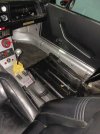I've done some rough calculations around the density of various cars which does corroborate that X1/9s are a little leaden as standard. The calcs are pretty rough, but they're about 144kg per m2 which is on par with the density of a lot of 90s cars (about when density peaks). Things like the NB MX5 after they put more crash protection in.
If they were built like an NA (so lightweight, but not necessarily floppy) they'd be spot on 800kg (131kg/m2). If they were built like a Spitfire they'd be 775kg (127kg/m2 for a MkIV).
I've been taking more of a 'build it like an NA MX5' approach with mine rather than 'build a racecar for the street'. It's Uno Turbo swapped so that's not helping it, but was 921kg with a full tank but without driver when I corner-weighted it. Since then I've:
Removed the spare wheel (-10kg)
Swapped in a Punto GT gearbox with custom subframe (all evened out to +2.1kg)
Added an oil cooler (+2kg)
Replaced the front metal bumpers with fibreglass ones (-0.5kg)
Deleted the luggage tray (-3.6kg) though likely will remake another in a lighter material
Removed the speakers (-0.8kg)
Whipped the bumper bolts out of the rear (-0.11kg)
Swapped in an alloy radiator with a tubular frame (-2.6kg)
Swapped the original fan for 2x modern slimline ones (-1.8kg)
Swapped the Mk2 roof for a Mk1 version (-2kg)
Changed the sound deadening in both footwells for dynamat (-2.4kg)
There's plenty left to do, but we're hovering just above 900kg at the moment. I've got about 30kg more identified without doing any significant chopping (FG boot, bonnet and engine cover, lexan rear window, lightweight flywheel, tubular manifold, half-sized washer tank, lightweight alternator, some other bits and pieces). If I can get it down to ~800kg I'll be overjoyed, but finding 70kg more without significant chopping will be difficult (not afraid of significant chopping, just don't have a place to repaint it afterwards!).



